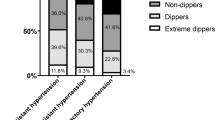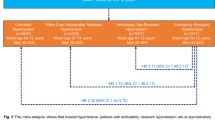Abstract
Resistant hypertension, defined as blood pressure (BP) remaining above goal despite the use of ⩾3 antihypertensive medications at maximally tolerated doses (one ideally being a diuretic) or BP that requires ⩾4 agents to achieve control, has received more attention with increased efforts to improve BP control rates and the emergence of device-based therapies for hypertension. This classically defined resistant group consists of patients with true resistant hypertension, controlled resistant hypertension and pseudo-resistant hypertension. In studies where pseudo-resistant hypertension cannot be excluded (for example, 24-h ambulatory BP not obtained), the term apparent resistant hypertension has been used to identify ‘apparent’ lack of control on ⩾3 medications. Large, well-designed studies have recently reported the prevalence of resistant hypertension. Pooling prevalence data from these studies and others within North America and Europe with a combined sample size of >600 000 hypertensive participants, the prevalence of resistant hypertension is 14.8% of treated hypertensive patients and 12.5% of all hypertensives. However, the prevalence of true resistant hypertension, defined as uncontrolled both by office and 24-h ambulatory BP monitoring with confirmed medication adherence, may be more meaningful in terms of identifying risk and estimating benefit from newer therapies like renal denervation. Rates of cardiovascular events and mortality follow mean 24-h ambulatory BPs in patients with resistant hypertension, and true resistant hypertension represents the highest risk. The prevalence of true resistant hypertension has not been directly measured in large trials; however, combined data from smaller studies suggest that true resistant hypertension is present in half of the patients with resistant hypertension who are uncontrolled in the office. Our pooled analysis shows prevalence rates of 10.1% and 7.9% for uncontrolled resistant hypertension among individuals treated for hypertension and all hypertensive individuals, respectively.
This is a preview of subscription content, access via your institution
Access options
Subscribe to this journal
Receive 12 digital issues and online access to articles
$119.00 per year
only $9.92 per issue
Buy this article
- Purchase on Springer Link
- Instant access to full article PDF
Prices may be subject to local taxes which are calculated during checkout

Similar content being viewed by others
References
Kearney PM, Whelton M, Reynolds K, Whelton PK, He J . Worldwide prevalence of hypertension: a systematic review. J Hypertens 2004; 22: 11–19.
Wolf-Maier K, Cooper RS, Banegas JR, Giampaoli S, Hense HW, Joffres M et al. Hypertension and blood pressure levels in 6 European countries, Canada, and the US. JAMA 2003; 289: 2363–2369.
Egan BM, Zhao Y, Axon RN . US trends in prevalence, awareness, treatment, and control of hypertension, 1988–2008. JAMA 2010; 303: 2043–2050.
Falaschetti E, Chaudhury M, Mindell J, Poulter N . Continued improvement in hypertension management in England: results from the Health Survey for England 2006. Hypertension 2009; 53: 480–486.
Verdecchia P, Gentile G, Angeli F, Mazzotta G, Mancia G, Reboldi G . Influence of blood pressure reduction on composite cardiovascular endpoints in clinical trials. J Hypertens 2010; 28: 1356–1365.
The ALLHAT Officers and Coordinators for the ALLHAT Collaborative Research Group. Major cardiovascular events in hypertensive patients randomized to doxazosin vs chlorthalidone: the Antihypertensive and Lipid-Lowering Treatment to Prevent Heart Attack Trial (ALLHAT). JAMA 2000; 283: 1967–1975.
Dahlof B, Devereux RB, Kjeldsen SE, Julius S, Beevers G, de Faire U et al. Cardiovascular morbidity and mortality in the Losartan Intervention For Endpoint reduction in hypertension study (LIFE): a randomised trial against atenolol. Lancet 2002; 359: 995–1003.
Brown MJ, Palmer CR, Castaigne A, de Leeuw PW, Mancia G, Rosenthal T et al. Morbidity and mortality in patients randomised to double-blind treatment with a long-acting calcium-channel blocker or diuretic in the International Nifedipine GITS study: Intervention as a Goal in Hypertension Treatment (INSIGHT). Lancet 2000; 356: 366–372.
Jamerson K, Weber MA, Bakris GL, Dahlöf B, Pitt B, Shi V et al ACCOMPLISH Trial Investigators. Benazepril plus amlodipine or hydrochlorothiazide for hypertension in high-risk patients. N Engl J Med 2008; 359: 2417–2428.
Turnbull F, Neal B, Ninomiya T, Algert C, Arima H, Barzi F et al. Effects of different regimens to lower blood pressure on major cardiovascular events in older and younger adults: meta-analysis of randomised trials. BMJ 2008; 336: 1121–1123.
Hebert PR, Moser M, Mayer J, Glynn RJ, Hennekens CH . Recent evidence on drug therapy of mild to moderate hypertension and decreased risk of coronary heart disease. Arch Intern Med 1993; 153: 578–581.
Wolf-Maier K, Cooper RS, Kramer H, Banegas JR, Giampaoli S, Joffres MR et al. Hypertension treatment and control in five European countries, Canada, and the United States. Hypertension 2004; 43: 10–17.
Sharma AM, Wittchen HU, Kirch W, Pittrow D, Ritz E, Göke B et al HYDRA Study Group. High prevalence and poor control of hypertension in primary care: cross-sectional study. J Hypertens 2004; 22: 479–486.
Giannattasio C, Cairo M, Cesana F, Alloni M, Sormani P, Colombo G et al. Blood pressure control in Italian essential hypertensives treated by general practitioners. Am J Hypertens 2012; 25: 1182–1187.
Sarafidis PA . Epidemiology of resistant hypertension. J Clin Hypertens (Greenwich) 2011; 13: 523–528.
Sarafidis PA, Georgianos P, Bakris GL . Resistant hypertension—its identification and epidemiology. Nat Rev Nephrol 2013; 9: 51–58.
Calhoun DA, Jones D, Textor S, Goff DC, Murphy TP, Toto RD et al. American Heart Association Scientific Statement. Resistant hypertension: diagnosis, evaluation, and treatment. Hypertension 2008; 51: 1403–1419.
Calhoun DA . Apparent and true resistant hypertension: why not the same? J Am Soc Hypertens 2013; 7 (6): 509–511.
Mancia G, De Backer G, Dominiczak A, Cifkova R, Fagard R, Germano G et al2007 Guidelines for the management of arterial hypertension: the task force for the management of arterial hypertension of the European Society of Hypertension (ESH) and of the European Society of Cardiology (ESC). J Hypertens 2007; 25: 1105–1187.
Pepine CJ, Handberg EM, Cooper-DeHoff RM, Marks RG, Kowey P, Messerli FH et al. A calcium antagonist vs a non-calcium antagonist hypertension treatment strategy for patients with coronary artery disease: the International Verapamil-Trandolapril Study (INVEST): a randomized controlled trial. JAMA 2003; 290: 2805–2816.
McAdam-Marx C, Ye X, Sung JC, Brixner DI, Kahler KH . Results of a retrospective, observational pilot study using electronic medical records to assess the prevalence and characteristics of patients with resistant hypertension in an ambulatory care setting. Clin Ther 2009; 31: 1116–1123.
de la Sierra A, Segura J, Banegas JR, Gorostidi M, de la Cruz JJ, Amario P et al. Clinical features of 8295 patients with resistant hypertension classified on the basis of ambulatory blood pressure monitoring. Hypertension 2011; 57: 898–902.
Persell SD . Prevalence of resistant hypertension in the United States, 2003-2008. Hypertension 2011; 57: 1076–1080.
Egan BM, Zhao Y, Axon RN, Brzezinski WA, Ferdinand KC . Uncontrolled and apparent treatment resistant hypertension in the United States, 1988–2008. Circulation 2011; 124: 1046–1058.
Hajjar I, Kotchen TA . Trends in prevalence, awareness, treatment and control of hypertension in the United States, 1988–2000. JAMA 2003; 290: 199–206.
Sim JJ, Bhandari SK, Shi J, Liu IL, Calhoun DA, McGlynn EA et al. Characteristics of resistant hypertension in a large, ethnically diverse hypertension population of an integrated health system. Mayo Clin Proc 2013; 88: 1099–1107.
Daugherty SL, Powers JD, Magid DJ, Tavel HM, Masoudi FA, Margolis KL et al. Incidence and prognosis of resistant hypertension in hypertensive patients. Circulation 2012; 125: 1635–1642.
Pierdomenico SD, Lapenna D, Bucci A, Di Tommaso R, Di Mascio R, Manente BM et al. Cardiovascular outcome in treated hypertensive patients with responder, masked, false resistant, and true resistant hypertension. Am J Hypertens 2005; 18: 1422–1428.
Salles GF, Cardoso CR, Muxfeldt ES . Prognostic influence of office and ambulatory blood pressures in resistant hypertension. Arch Intern Med 2008; 168: 2340–2346.
Redon J, Campos C, Narciso ML, Rodicio JL, Pascual JM, Ruilope LM . Prognostic value of ambulatory blood pressure monitoring in refractory hypertension: a prospective study. Hypertension 1998; 31: 712–718.
Jung O, Gechter JL, Wunder C, Paulke A, Bartel C, Geiger H et al. Resistant hypertension? Assessment of adherence by toxicological urine analysis. J Hypertens 2013; 31: 766–774.
Acelajado MC, Pisoni R, Dudenbostel T, Dell'Italia LJ, Cartmill F, Zhang B et al. Refractory hypertension: definition, prevalence, and patient characteristics. J Clin Hypertens (Greenwich) 2012; 14: 7–12.
Cushman WC, Ford CE, Cutler JA, Margolis KL, Davis BR, Grimm RH et al The ALLHAT Collaborative Research Group. Success and predictors of blood pressure control in diverse North American settings: the Antihypertensive and Lipid-Lowering and Treatment to Prevent Heart Attack Trial (ALLHAT). J Clin Hypertens 2002; 4: 393–404.
Acknowledgements
This review was supported by the National Institutes of Health Grant T32 HL007457 (to EJ).
Author information
Authors and Affiliations
Corresponding author
Ethics declarations
Competing interests
The authors declare no conflict of interest.
Rights and permissions
About this article
Cite this article
Judd, E., Calhoun, D. Apparent and true resistant hypertension: definition, prevalence and outcomes. J Hum Hypertens 28, 463–468 (2014). https://doi.org/10.1038/jhh.2013.140
Received:
Revised:
Accepted:
Published:
Issue Date:
DOI: https://doi.org/10.1038/jhh.2013.140
Keywords
This article is cited by
-
Association of priori-defined DASH dietary pattern with metabolic health status among Iranian adolescents with overweight and obesity
Scientific Reports (2024)
-
Cost Effectiveness of Endovascular Ultrasound Renal Denervation in Patients with Resistant Hypertension
PharmacoEconomics - Open (2024)
-
Role of home blood pressure monitoring in resistant hypertension
Clinical Hypertension (2023)
-
Polygenic scores for estimated glomerular filtration rate in a population of general adults and elderly – comparative results from the KORA and AugUR study
BMC Genomic Data (2023)
-
Adherence to secondary prevention recommendations after coronary artery bypass graft surgery
Irish Journal of Medical Science (1971 -) (2023)



